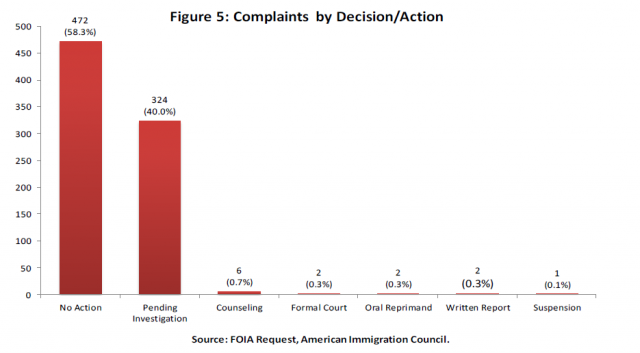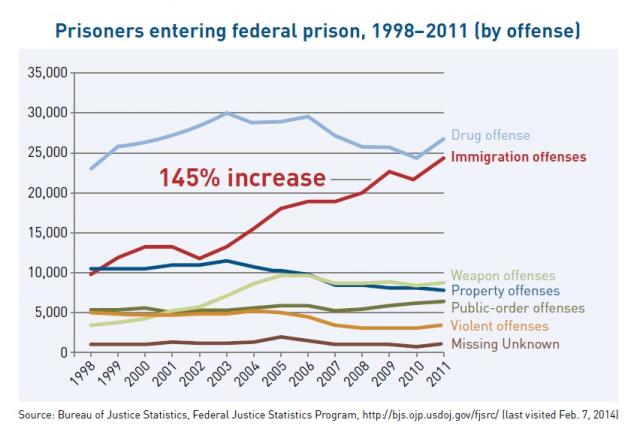The militarization of the U.S.-Mexico border has also meant a multiplication of Border Patrol personnel, an increase in detention centers, expedited removal of undocumented immigrants, and an outsourcing of many of these services to private contractors. The system of apprehension, detention, and deportation lacks transparency and accountability, and encourages the trampling of human rights.
The rapid expansion of the Border Patrol in the last decade has created problems with training and screening. Coupled with the military-style operations and ideology, this has led to an agency that is rife with abuse towards undocumented people and residents. The Southern Border Communities Coalition identifies “a deeply ingrained culture of violence” in the Border Patrol agency that is “out of control and operates with impunity.” The problem has not been addressed within the Department of Homeland Security, and it is difficult for the public to gain access to information about how allegations of abuse are handled.
This 2021 report from National Lawyers Guild National Immigration Project, COMPLAINTS IGNORED, ABUSES EXCUSED: Why the Department of Homeland Security’s Internal Accountability Mechanisms Must Be Reformed is a summary of abuses stemming from the National Immigration Project’s call to its membership and allied organizations for Department of Homeland Security (DHS) complaints of harm caused by ICE and CBP personnel, including those that went unaddressed or were improperly closed by the last administration. “We were inundated with responses representing hundreds of cases of abusive conduct. This report presents summaries intended to capture common themes in those complaints and to elevate the trends of abuse and suffering they reveal. In asking DHS to carefully review and act upon each individual claim, as well as reform its complaints system as a whole, our goal is to honor the experiences of every immigrant who has been mistreated.”
The Biden-Harris administration has both the opportunity and the imperative to address DHS’s fragmented and ineffectual complaints system. While many oversight personnel undoubtedly carry out their duties professionally, these complaints cast doubt on OIG, CRCL, and the OPRs’ collective and individual abilities to be effective in achieving accountability. They are constrained by institutional design flaws, jurisdictional haziness, and a departmental pattern of failing to redress policy violations directly traceable to DHS officers and agents. We look forward to beginning meetings with the Administration on an ongoing basis to tackle these serious, unacceptable concerns.
BORDER ENFORCEMENT UNCHECKED VIOLENCE AND ABUSES
Since its move to the Department of Homeland Security, the Border Patrol has remained relatively immune to public scrutiny and external oversight. This freedom has led to the unchecked development of an institutional culture of impunity. This is particularly evident when examining data available on agents’ use of lethal force. In 2014, the acting chief of internal affairs for Border Patrol stated that he was not aware of any agent being formally disciplined for killing someone since 2004, a decade that included 46 incidents in which Border Patrol killed people.
According to a report by the American Immigration Council, between 2009 and 2012, 97% of the cases opened resulted in “No Action Taken” decisions:
American Immigration Council’s report describes that, “For years it has been reported that U.S. Border Patrol agents routinely ignore the constitutional and other legal rights of both immigrants and U.S. citizens. More precisely, agents of the Border Patrol are known for regularly overstepping the boundaries of their authority by using excessive force, engaging in unlawful searches and seizures, making racially motivated arrests, detaining people under inhumane conditions, and removing people from the United States through the use of coercion and misinformation.”
After public pressure and FOIA lawsuit from the ACLU in 2014, CBP was forced to release a 2013 report on their use of force policy from the respected think tank Police Executive Research Forum (PERF). Among its key findings was that CBP agents intentionally placed themselves in harm’s way to justify deadly force, such as standing in front of moving vehicles and rock throwers rather than moving out of the way. Overall, the report charged CBP with a “lack of diligence” in internal investigations and thus “tacit approval” of brutal practices. CBP released new use-of-force policies that took PERF’s recommendations into account, but with the lack of accountability or transparency, these changes have had little effect in undoing the BP’s culture of violence. CBP has still taken no disciplinary or legal action against the agents involved in the 67 deadly-force incidents addressed by the PERF report.
Hold CBP Accountable is a website that “documents litigation across the country in an ongoing effort to establish accountability and transparency of one of the fastest growing agencies in the United States.” The website also compiles reports and resources on the subject.
Issues with corruption are also common in an agency that lacks systems of accountability and transparency. The Center for Investigative Reporting maintains an online database of Border Patrol corruption cases called “Crossing the Line: Corruption at the Border.”
VIOLENCE AND MISTREATMENT DURING DETENTION
People arrested by Border Patrol are held in the custody of a variety of agencies, including CBP, ICE, and the U.S. Marshals. The immigrant detention system is embedded within border enforcement, and is often outsourced to private prisons corporations under little to no scrutiny.
The ACLU released the results a multi-year investigation on five of the thirteen private prisons for undocumented immigrants. They found overcrowded facilities, overuse of isolated confinement, continuous verbal and physical abuse from agents, lack of in-prison educational or work opportunities, insufficient medical care, squalid living conditions, and other human rights abuses. This is the reality for more than 25,000 immigrants in detention centers, with private contractors incessantly seeking to expand their facilities.
Many detainees have embarked on campaigns to improve conditions and resist the private prison industrial complex. At Tacoma’s Northwest Detention Center, a group of women organized a hunger strike in April 2017. A group of Tacoma residents formed a group called NWDC Resistance, and worked in solidarity with the striking detainees to put pressure on GEO Group, the private prison company operating the facility.
Detention Watch Network (DNW) also released a 2013 report on the abuses and absence of accountability in immigration detention centers. DNW exposes that these facilities continue “plagued by deaths and suicides, subpar medical and mental health care, inedible food, and arbitrary restrictions on visitation and access to legal resources.”
Human Rights Watch published a report on the unfair proceedings and detention immigrants with mental disabilities face. A population that is often forgotten in discussions about immigration and the border, individuals with mental disabilities are in especially vulnerable situations in the detention and deportation system.
The University of Arizona’s 2013 Migrant Border Crossing Study compiled information from over a thousand interviews with deportees about their experiences with violence at the border. They provide evidence of Migrant Mistreatment While in Custody as well as their Possessions Take and Not Returned.
Immigration and civil rights organizations have also filed complaints regarding physical and sexual abuse against minors crossing the border.
DENIAL OF THE RIGHT TO SEEK ASYLUM AT PORTS OF ENTRY
In the months following Trump’s inauguration, rights groups and advocates heard reports from the border than asylum seekers were being turned away, intimidated, and given false information by CBP officers at ports of entry along the U.S.-Mexico border. In May 2017, Human Rights First released a report, “Crossing the Line,” which was based on 125 cases of asylum seekers turned away at ports of entry by CBP agents. These actions are explicit violations of U.S. law and treaty obligations. In July 2017, a lawsuit was filed on behalf of six asylum seekers to prevent CBP officers from behaving in these ways. An audio recording released by Human Rights First provides evidence of such encounters.
To learn the basics on the right to seek asylum and the U.S. process of evaluating asylum claims, read this fact sheet from the American Immigration Council.


